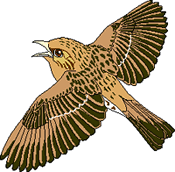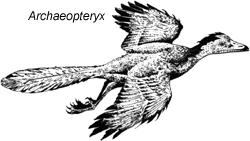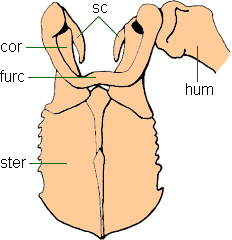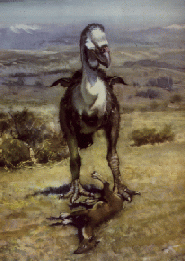Vertebrate Flight
AVIAN FLIGHT
|
|
 |
 |
|
The earliest known bird is Archaeopteryx. Its form shows us that it was a true flyer, although not as skilled as most modern birds, since its sternum was flat, or at best only slightly keeled, and later modifications of the wrist bones were not present. It is this first bird and its closest relatives that we must consider when discussing the origin of flight in birds, because later birds are more modified in structure, and hence are inaccurate models for understanding the origin of flight in the avian lineage. In support of Archaeopteryx as one of the model ancestral birds, there is a line of later transitional forms during the Cretaceous period — forms such as Confuciusornis and Sinornis that show the rapid evolution of flight in birds, quickly approaching the structure seen in most modern flying birds.
 A generalized bird pectoral girdle (sc= scapula, cor= coracoid, hum= humerus, furc= furcula, ster= sternum). Adapted from Padian 1985. |
|
Dromaeosaurs, Archaeopteryx, and early birds such as Sinornis, then, are the animals that we must consider to understand the origin of flight in birds. Dromaeosaurs were all bipedal, fairly cursorial, and terrestrial. There is no persuasive evidence indicating arboreality in dromaeosaurs, although that negative evidence does not preclude arboreality altogether. Many modern birds are arboreal, but modern birds have had 150 million years of evolutionary separation from their origin, so they are poor analogs for the origin of flight in birds (as Dr. Padian {1985} says, "To study the origin of flight is not to deal with why modern birds live in trees, but how ancient birds got into the air. Post hoc arguments are not acceptable [p.419 — see sources in the Introduction to Flight exhibit])."
Dromaeosaurs such as Deinonychus, the model for the "raptors of Jurassic Park, were fierce predators that used their forearms in a motion that was very similar in unusual ways to the flight stroke of used in birds. Professor Kevin Padian and Dr. Jacques Gauthier (then a student at Berkeley and now a professor at Yale University) first showed this in 1985. More recently, Dr. Alan Gishlick, a research associate at UCMP, explained in more detail how this stroke evolved. See "New Perspectives on the Origin and Early Evolution of Birds," edited by J.A. Gauthier and L.F. Gall (Yale Univ. Press, 2001)
 A generalized bird wing (hum= humerus, r= radius, u= ulna, c= carpus, mc= metacarpus, I-III= numbered digits). Adapted from Padian 1985. |
|
Birds have flight adaptations similar to those of pterosaurs: hollow but strong bones, keeled sterna (shown above) for flight muscle attachment, short and stout humeri, and feathers (analogous to pterosaur wing fibers). However, unlike the pterosaur wing, the bird wing (shown above) is primarily supported by an elongated radius, ulna, and modified wrist bones (the carpometacarpus). Among other features, birds have a structure that they share with dromaeosaurs: a fused clavicle (collarbone) called the furcula (wishbone), which serves as a brace during the flight stroke. This feature was probably co- opted in function from the dromaeosaurian function of providing a brace for the shoulder girdle while holding prey.
The phalanges of the bird wing (homologus to those of the ancestral dromaeosaurian hand) follow a trend of reduction and fusion to form the distal part of the wing: dromaeosaurs had large clawed hands, Archaeopteryx had clawed fingers and a more elongate wing, and modern birds have mostly only the second digit of the hand present (at the end of the wing). The same group also shows an evolutionary trend of the reduction of flexion in the wrist, making the flight stroke more rigid and pronounced. Later birds did not have the stiff tail of Archaeopteryx; tails seem to be structures reserved for more primitive flyers.
 |
|
Birds showed a gradual increase in flying ability during their early evolution — Archaeopteryx was not a powerful flyer, but it seems it was not much of a glider either. Later birds such as Sinornis, Confuciusornis, and Ichthyornis improved on the basic flight adaptations of their ancestors, becoming better flyers. Some birds found niches that were more suited for flightless birds: Hesperornis was a flightless diving bird in the late Cretaceous period, and in the Eocene epoch (shortly after the demise of the dinosaurs), there were large flightless birds such as Diatryma that may have been the main predators on the early mammals in some areas (a Miocene flightless bird, Phorusrhacos, is depicted at left). Penguins and other diving birds do not fly in the air, but use the same basic flight stroke to fly under water. The living ratites (ostriches, emus, kiwis, and the extinct moa) are an ancient lineage of flightless birds. And of course, today we have such adept flyers as the swallows, hummingbirds, falcons, and the soaring albatrosses which demonstrate the great diversity of flight adaptations in birds.
Three Solutions to Flight
Chiropteran Flight
Pterosaurian Flight
You may also wish to look at these images taken of birds in flight, showing the mechanics of their stroke.